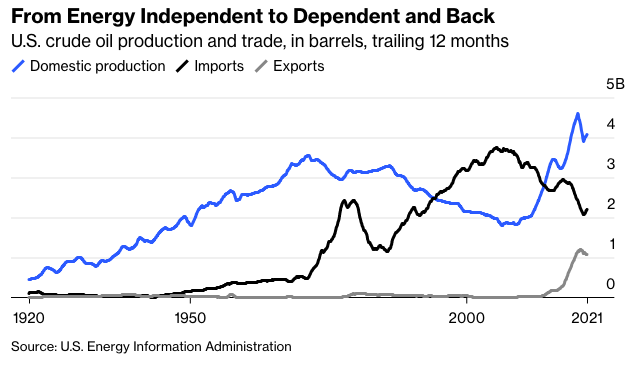In 2020, for the first time in 69 years, the U.S. exported more energy than it imported. The numbers for 2021 aren’t all in yet, but everything is pointing to an even bigger energy surplus. The long journey that began during the 1973 oil crisis with President Richard Nixon’s “Project Independence” and its goal of “achieving self-sufficiency in energy” would seem to have ended.
Yet as Russia invades Ukraine, threatening disruption of global oil supplies, Americans aren’t exactly celebrating their energy independence. Instead, they’re fuming about high gasoline prices, with some even arguing that those prices are so high because President Joe Biden “destroyed American energy independence.” It’s mostly Republicans who say that, but some Democratic lawmakers have been pushing the White House (so far without success) to curb oil and gas exports to bring prices down at home. Meanwhile, the U.S. and its allies are constrained by Russia’s oil and gas riches in their reactions to its assault on Ukraine.
So … maybe energy independence isn’t all it’s cracked up to be. Or maybe being a net exporter of energy doesn’t really make a country energy-independent.
Producing more energy than you consume does, to be sure, seem to be the standard definition of energy independence. For example, Eurostat, the European Union’s statistical agency, has a metric called “energy dependence” that is simply net imports as a percentage of energy use. Malta was Europe’s most energy-dependent country in 2020, at 97.6%. Germany, a big importer of Russian natural gas, came in at 63.7%. Fifteen years ago, U.S. net energy imports amounted to 29.1% of energy consumption. Now, thanks mainly to the boom in domestic production of oil and natural gas enabled by hydraulic fracturing and horizontal drilling, they’re negative.
But President Nixon, President Jimmy Carter and other advocates of energy independence through the decades have had more than just this simple accounting in mind. Nixon said in 1973 that he was concerned about the “maintenance of our ability to play our independent role in international affairs.” Carter worried in 1977 that the world was “running out of petroleum,” and that this would wreak economic havoc without concerted efforts to conserve energy and come up with new sources. Most talk of energy independence falls into those two baskets, which I’ll define as:
Sometimes these two aims are compatible, sometimes they aren’t. Germany and other European nations would have a lot more freedom to maneuver on Ukraine if they weren’t so dependent on Russian natural gas, but without it they would have paid a lot more for energy over the past few decades. Countries with limited energy resources generally don’t strive for self-sufficiency because they can achieve better economic results with imports—being heavily dependent on fossil fuels from abroad certainly didn’t thwart the economic rise of Japan and China. Countries with lots of energy resources generally don’t strive for self-sufficiency either, because they can achieve better economic results by exporting.
It’s a balancing act, and the optimal level of dependence or independence is neither obvious nor constant over time. Then again, it does seem like Germany’s 2011 decision to shut down all its nuclear power plants was a pretty clear (and clearly mistaken) step away from energy independence, reducing both its freedom from foreign power and its freedom from economic harm.
The U.S. is a unique case, having risen to global economic preeminence in the first half of the 20th century fueled almost entirely by domestic coal, oil and gas that was in turn virtually all consumed domestically. Monthly U.S. crude oil statistics are available all the way back to 1920, and they tell the story nicely—including the big post-World War II plot twist when domestic production stopped keeping up with demand. (There are annual statistics going back as far as 1859, but the numbers involved before 1920 are so small that they don't add much to the overall picture.)

• Freedom from foreign power.
• Freedom from economic harm.








